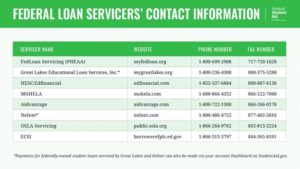If the emails, phone calls, and text messages you’re receiving about student loan forgiveness are setting off your scam sensor, we’ve got you covered. Learn more about the most common student loan forgiveness scams and how to avoid them.
Scams can come in all shapes and sizes. You may be more likely to stumble upon scams tied to current events like “pandemic grant” or “Biden loan forgiveness.” But sometimes it’s as simple as a fraudulent promise to work fast and save you gobs of money. Remember: A scam doesn’t have to be elaborate or complex.
There are real federal loan forgiveness programs out there, including Public Service Loan Forgiveness (PSLF) and Teacher Loan Forgiveness. But many companies will try to take advantage of borrowers by guaranteeing immediate results or requesting money up front for services they cannot provide.
Keep an eye out for these common scams.
Here are some examples of false claims you might come across:
• “Act immediately to qualify for student loan forgiveness before the program is discontinued.”
• “Your student loans may qualify for complete discharge. Enrollments are first come, first served.”
• “Student alerts: Your student loan is flagged for forgiveness pending verification. Call now!”
Though the U.S. Department of Education (ED) may reach out to highlight temporary programs like the limited PSLF waiver, aggressive advertising language like the above will not come from ED or our partners.
Scammers will frequently request an up-front or monthly fee while promising immediate and total cancellation. They may even ask for your FSA ID (account username and password). All of these should be red flags. Most government forgiveness programs require years of qualifying payments and/or employment in certain fields before forgiving loans. And, of course, ED and its partners will never ask for your FSA ID password. That’s a guarantee.
If you receive a questionable message promising student loan forgiveness and aren’t sure what to make of it, keep an eye out for any unusual capitalization, improper grammar, or incomplete sentences. These sorts of errors indicate a potential scam in action.
Don’t pay for help with loan debt relief (at least not right away!).
If you’re having difficulty paying for your student loans, your first step should be to contact your loan servicer. Some debt relief companies will charge a fee for services that you and your servicer can work out together, for free.
If you’d like to
• lower your monthly loan payment,
• consolidate multiple federal student loans,
• switch to a new repayment plan, or
• see if you qualify for loan forgiveness,
ED and our affiliated federal loan servicers can help.
Getting assistance from a private, unaffiliated debt relief company doesn’t necessarily mean you’ll be scammed. But seeking out unverified services is a common way to stumble into a student loan forgiveness scam.

I’ve uncovered a potential student loan forgiveness scam. What do I do?
If you’ve stumbled upon what might be a student loan forgiveness scam, please let us know. Submit a complaint with us to file a report of suspicious activity.
If you think the scam involves your FSA ID, or if you’ve shared your FSA ID details with someone whom you now suspect to be a scammer, be sure to log in and change your account password as soon as possible. You should also check your account information (contact email, address, and phone number) to make sure it’s still accurate. Lastly, you should still file a complaint so we can monitor your account for continued suspicious activity. Again, ED and our partners will never ask for your FSA ID password.
Help, I’m being scammed! What do I do?
If you find yourself in the process of being scammed, act fast and pursue one or all of these options:
• Contact your federal loan servicer to make sure no unwanted actions were taken on your loans (or to revoke any authorization agreement that your servicer has on file).
• Contact your bank or credit card company to stop all payments to the company that is scamming you.
• Submit a complaint to us.
• File a complaint with the Federal Trade Commission (FTC).
• File a complaint with the Consumer Financial Protection Bureau (CFPB).
